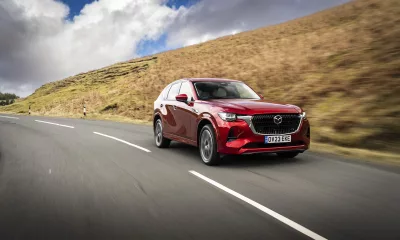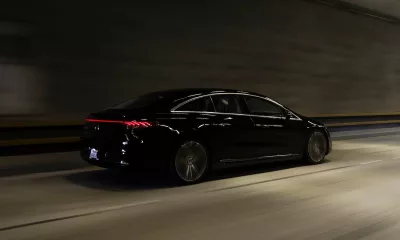

With feet firmly planted in Porsche’s motorsport past and its nose cresting the final apex of the 991.2’s impressive track record, the GT3 RS is as much timebomb as it is time capsule…
For most, the passing of a single second is inconsequential but, in the microcosm of the millisecond-increments of a second hand between indices on a watch face, our world buzzes with activity. Nowhere is this more graphically evident than mid-corner at the wheel of Porsche’s most focused take on its 911: the lightweight and razor-sharp GT3 RS.
Here the blink of an eye spans just 200 milliseconds and 15 milliseconds later your brain receives the image of the upcoming corner. The swirl of chemicals and neurons firing that bridge the gap between such stimuli as the pressure of your spine being pressed into the seatback and the howl of the thinly insulated engine over your shoulder takes an almost glacial 500 milliseconds to be processed into a conscious experience and you register that a downshifting tug on the left paddle of the dual-clutch transmission is the next best course of action.
An electrical signal from your brain courses through the channel of nerves that terminate in your hand, causing your fingers to contract 135 milliseconds later. In the final 100 or so milliseconds, the paddle-pressure – electrical signal – mechanical downshift chain reaction of the RS’s transmission is done and dusted, and the car awaits its next cue from your comparatively slow and overawed nervous system before the clock’s hand closes out a single second.
The RS is all about those increments; peeling a kilogram here and fine-tuning a mechanical component there, in the pursuit of shaving milliseconds off whatever performance task you could ask of a 911. So, as the final increment on the 991.2-generation 911’s illustrious timeline, it’s somewhat fitting the RS has been chosen to close the show with a bang. But when it comes to honing one of the most balanced sportscars on the road to a racing-homologation razor’s edge, it bears asking if taking away so much in terms of refinement and convenience could cut a little too close to the bone?
Before answering, let’s put the GT3 RS nomenclature into historical perspective. Without getting too mired in the details, the RS suffix was first applied to a motorsport homologation (Rennsport in German) of the 911 Carrera in 1973. It stripped out all that was heavy and superfluous to racing and replaced many of the road car’s components with lightweight substitutes. In addition to the stiffened suspension and some neat aero bits such as the “ducktail” spoiler, Porsche’s engineers upped the wick on the 2,8-litre flat-six engine. The GT3 bit can be traced back to 1999, with the requirement for a road-going race-homologation model of the 996 to meet the requirements of the FIA’s Group GT3 racing series and terminating with the car you see here.
In all that time, little has altered in the making of an RS-badged 911; the simple tenets of stripping unnecessary weight, honing the chassis and squeezing more performance from the engine remain intact.
In the 991.2 car, the RS treatment begins with a wide-body aero kit and the adoption of carbon-fibre-reinforced plastic (CFRP) for front and rear lids and front wings, while the fore and aft aprons are fabricated from lightweight polyurethane. The side and rear glazing are replaced with thinner glass. In a refreshing departure from a world where automotive vent work is largely cosmetic, the RS’s NACA air intakes on the front lid and ventilation ports on the rear wings not only add to the car’s intimidating appearance, but form an integral part of the air supply to both the brakes and engine, while the louvres on the front wings contribute to downforce.
Our test unit’s optional Weissach package ups the visual ante and pares down the car’s kerb weight with a roof and that huge Porsche-emblazoned rear wing fashioned from CFRP.
The motorsports motif continues in the cabin, where – barring the infotainment system and one or two other convenience features – things have been whittled to their lightweight and functional best; even the door handles have made way for canvas pull straps. Although deemed a practical feature but seldom used as anything more than a luxuriously upholstered parcel shelf, the rear seats have been removed and, in the case of our Weissach-equipped test unit, a lightweight roll cage has been bolted in behind the front seats. Although spartan, the cabin’s impressive perceived quality is everything you’d expect of a 911, albeit less isolated from road and mechanical noise thanks to the removal of much of the sound-deadening and the thinner-gauge glass in the side and rear windows.
Turn the key fob – there’s none of that fancy push-button stuff here – and the 4,0-litre flat-six barks into life. This naturally aspirated unit is based on the 911 GT3 Cup’s and features all-aluminium construction for the block and cylinder heads, while lightweight titanium is used for the connecting rods. In addition to direct fuel injection and an uprated dry-sump lubrication system, the engine features a variable camshaft-timing arrangement that incorporates cam followers and substitutes hydraulic valve-to-camshaft clearance for rigid shim-plate spacers in a more robust construction that allows for greater engine speeds … a staggering 9 000 r/min.
The journey to the rev limit isn’t strained, either. Planting the throttle quickly swings the rev needle into the red, while the 470 N.m of torque chimes in at the 6 000 r/min mark and 383 kW is channelled to the rear wheels just 2 250 r/min later.
Without turbos and their associated plumbing, the naturally aspirated unit breathes freely and serves up its power in a linear and seemingly unrelenting surge. Along with the motorsport-worthy howl of the motor and the odd bit of backfire from the lightweight stainless-steel exhaust system during upshifts, the car breasted 100 km/h from standstill in just 3,55 seconds in our acceleration testing. Keeping the throttle pinned – an action that should be undertaken only in controlled environs, lest you wish to part with your civil liberty – will eventually see the RS topping out at 312 km/h.
Breathtaking as its power and straight-line speed are, it’s the RS’s ability to transfer these forces into corners, crests and cambers that really impresses. Beneath your seat, the chassis features race-tuned (read significantly stiffer) spring rates, along with transverse and longitudinal links for the lightweight MacPherson front suspension and multilink rear. Both benefit from anti-roll bars and coupling links made of lighter, softer CFRP that reduces roll rates and keeps everything flat under hard cornering. Although, the result of their interplay with such innovations as lateral torque vectoring, rear-axle steering and a stability control system with two-stage shut-off is the stuff of motoring heaven.
Some cars simply talk to you. Their weighty steering and supple chassis lend a closer connection to the road. The RS is on another level … it feels as though it’s hooked into your cerebellum. The steering is light but so communicative and responsive that placing the car on a desired patch of tarmac feels like a nervous reaction; you barely give it any thought. Directional changes are instantaneous but you don’t feel as though you’re being wrenched around. Rather, you feel an involved and vital organic part of a racing machine, ensconced in that racing bucket that pins you in place and allows you to accurately sense the approaching limits of the car’s stupendous mechanical grip.
Pick your line, feel the steering weight on the turn-in and marvel at the swift yet fluid way the 380 mm disc brakes scrub off speed into a bend. The absence of the pause that usually ensues between pulling on a shift paddle and gears engaging is slightly disarming. You draw breath as a dig at the throttle slingshots you away from the apex and perfectly lines you up for the next twist in the road. And all of this happens in a split second.
The feeling is hard to describe. It is a combination of awe that this car allows you to dip into a deepening well of driving dexterity, interspersed with occasional gut-plunging doses of terror when that huge reserve of confidence-inspiring grip makes way for an unnerving lightness at the back as traction suddenly wanes when you overzealously tackle wet roads. Although the stability control system does provide a safety net, its intervention is measured and allows for some slip. Turn it off completely and steady nerves and an educated toe on the throttle may be your only saving graces.
With this in mind, you can only imagine the veritable lightning storm of neural and electrical signal fireworks in both man and machine that accompanies every second of a sweeping run along a mountain pass in the RS.
It certainly eclipses the eternity spent in traffic or town driving in the RS. That rock-solid, communicative chassis which fed every nuance of the car’s grip and road conditions to your frame thumps sullenly over rippled tarmac. The chorus of exhaust cracks and the spine-chilling howl of that flat-six is replaced with a breathy, metallic rasp at low revs and the dull clicks and clonks of the transmission and differential worm their way into the barely insulated cabin. Now, the only physical reactions are an inadvertent tightening of your jaw and the odd glance at the centre console to flip the switch and raise the optional front chassis to avoid leaving remnants of the car’s front apron on any speedbumps. Motorway driving is similarly grating with plenty of mechanical and wind noise but such motoring flies in the face of what the RS is built for and the car rightly chides you for subjecting it to such a banal waste of its talents.
TEST SUMMARY
The GT3 RS is a fitting swansong for a 991.2 GT series that’s managed to excite, cosset and at times even intimidate. As intended, it’s an unapologetic racecar for the road; eschewing ride comfort and NVH suppression in favour of undiluted driving thrills. Although not necessarily possessed of the multi-cylinder firepower of supercars in its price bracket, the RS allows you to harness that power and transfer it to the road in a way few cars can match. Sadly, it’s no longer on sale but our brief stint behind its wheel had us so captivated by its raw charm and poise that we simply had to subject it to a formal road test. It is one of the most impressive performance cars we’ve tested in some time and we thoroughly enjoyed every single second.




